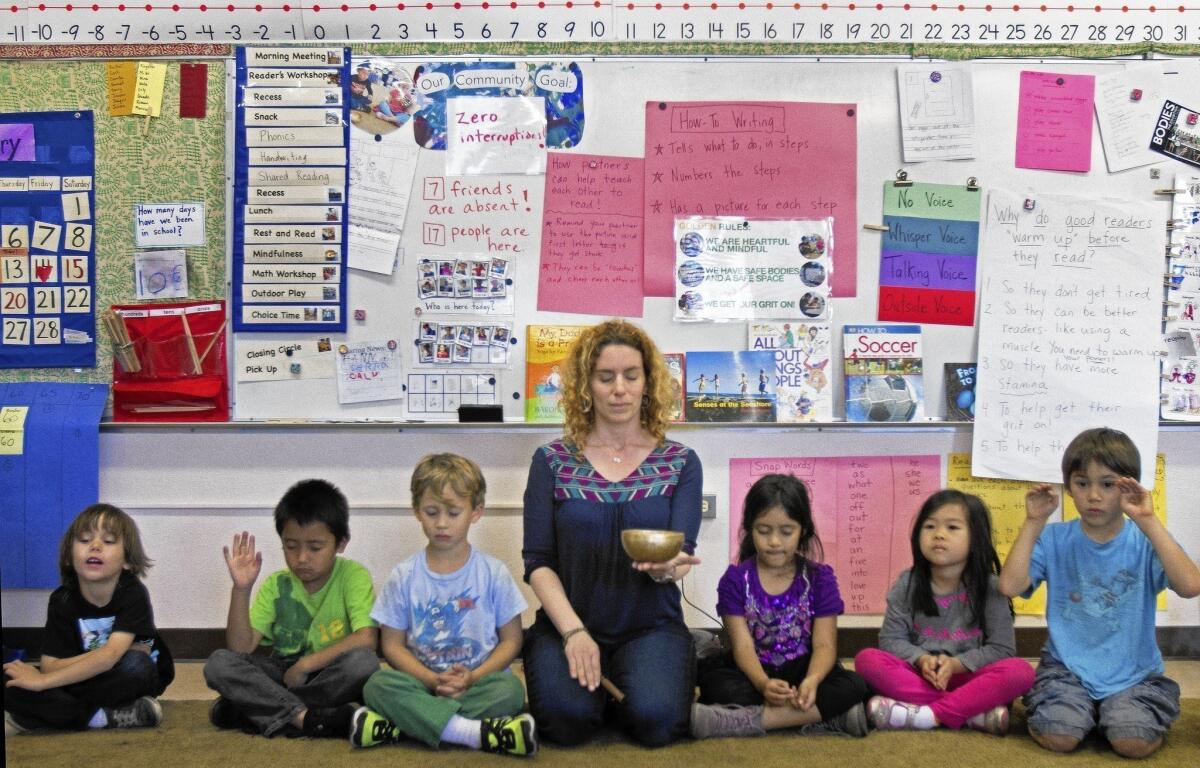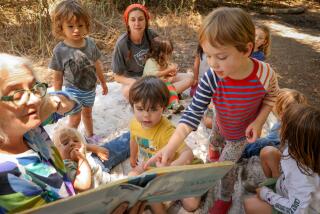Mindful meditation at school gives kids tools for emotional expression

Erica Eihl speaks in a voice that her kindergartners can hear only if they are as quiet as the church mice in childrenâs storybooks.
And with a couple of squirrelly exceptions, they stay that quiet for 15 or 20 minutes â a near eternity â as Eihl guides them to use all their senses to consider a piece of apple, with directions such as, âLooking at the apple, look on the outside. Look on the inside.⌠Remember, keep it in your palm and just look at it.â
When she asks for their input, she gets raised hands and comments such as: âIt smells juicy and apple-yâ and âI see little tiny white spots.â
Mindful eating is just one of the mindful practices at the Citizens of the World charter school in Mar Vista, with 160 children in kindergarten through second grade.
âWe are mindful and heartfulâ is the golden rule at the school, and the children practice mindful meditation in the mornings and after recess, among other times, often with 30 seconds to five minutes of silence â time when they can notice what is happening at the moment without judgment, which is at the heart of mindful meditation.
âTheyâre very receptive to it,â Eihl says. âTheyâre so emotional at this age. Itâs allowing them to have the tools to be expressiveâ about their emotions and cope with them.
Educators are catching on to the benefits of mindful meditation.
Indeed, schools in 48 states, and hundreds of schools in California alone, have programs, says Chris McKenna, the program director at Mindful Schools in Emeryville, Calif., which has trained more than 2,000 teachers in mindfulness.
âOne of the reasons itâs growing is because the kids are under so much pressure now, with the testing culture and the pressure put on them by teachers and parents to be successful,â says Vicki Zakrzewski, the education director at the Greater Good Science Center at UC Berkeley, which studies the science behind mindfulness.
Mindfulness helps with focus, attention and calming the emotions, she says. Teachers and administrators, she adds, see it as a tool that also can boost school performance.
âSchools are absolutely paying attention to the benefits of mindfulness,â says Lorraine Hobbs, the director of youth and family programs at UC San Diegoâs School of Medicine and Center for Mindfulness. âWhen we can teach kids to pay attention to this inner landscape,â they can learn kindness and compassion.
Mindful meditation came to schools in part as they began to focus on social and emotional aspects of learning, sometimes to cope with bullying and other behavioral problems, Zakrzewski says. âWe focus so much on cognitive development, but the science is showing us how important the social and emotional aspects are.â
Itâs more than just a ânice experience,â says Sharon Salzberg, a meditation teacher and author of the recent book âReal Happiness at Work.â âJust like with adults, stress takes its toll, and we need to take breaks and regroup. And maybe itâs as simple as remembering to breathe.â
Hobbs says itâs important for the adults in a school to develop a mindfulness practice. âYou canât teach what you donât know,â she said.
That might look like a daily meditation time, perhaps 20 minutes or so, using directions downloaded onto an iPhone. Or taking part in a group meditation program. And it also means teachers are aware of mindful ideas throughout the day.
Several experts likened the current state of mindfulness to the way people approached yoga a few decades back. These days childâs pose is part of everyday language, but not so long ago yoga was seen as kooky or, worse, some odd religious practice. Like yoga, mindfulness is rooted in contemplative religious practice and like yoga has been secularized and is used as a complementary medical treatment for many conditions, as well as in schools.
At Citizens of the World, Principal Alison Kerr says, mindfulness can help equip children for the world theyâre growing into by giving them tools to âidentify and cope with their own feelings, to be still and attentive to whatâs going on around them.â
The classrooms have âpeace corners,â spots with cushions, chairs, pine cones, shells, books and other items. There are headphones to block out distracting classroom noise. Children can go there to âtake fiveâ when they are overwhelmed by their feelings or unable to manage whatâs going on in the class.
âMindfulness has been my favorite thing in my whole life,â says one of the students, Alia Briglia, 6. âWhen Iâm mad, sad or frustrated, I go to the peace corner.â







